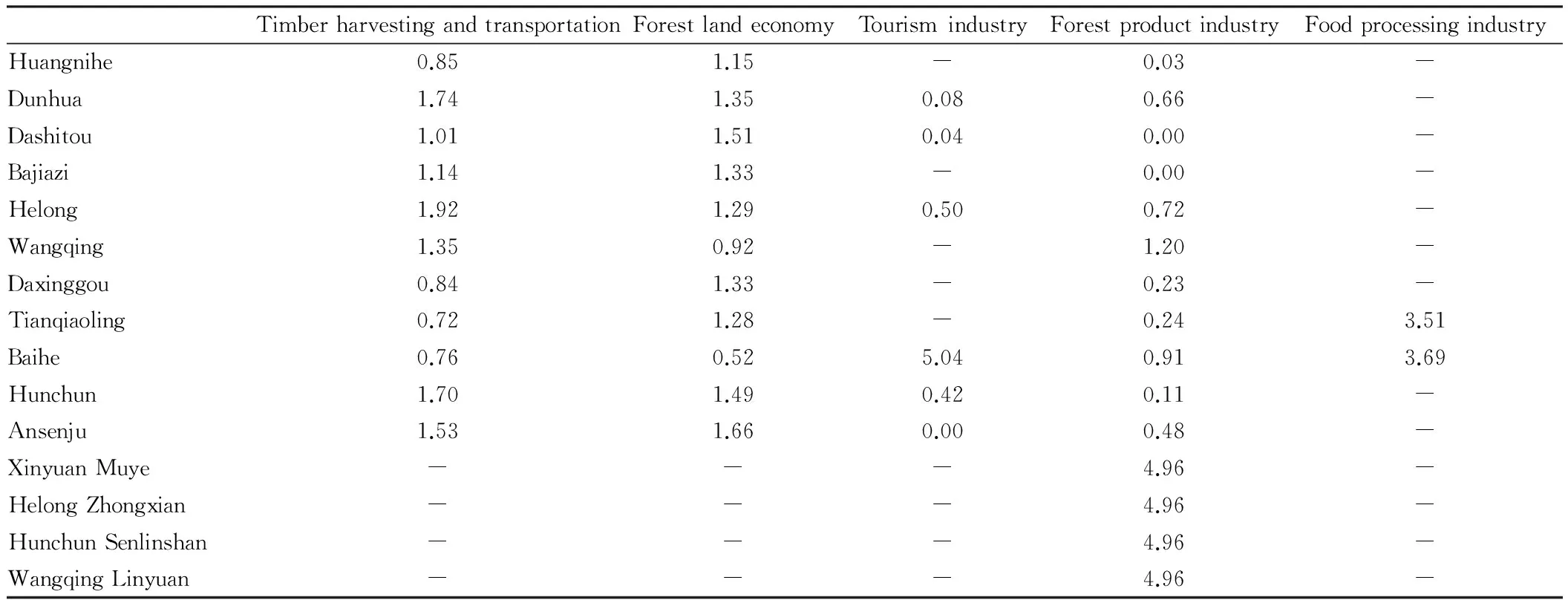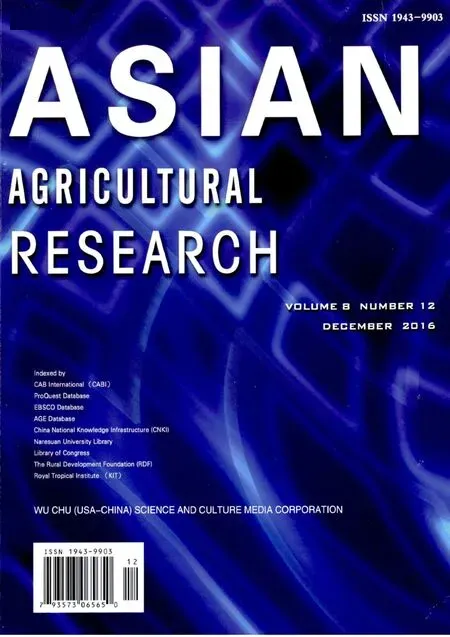Study on the Layout of Forestry Industry in Yanbian
,
Yanbian University, Yanji 133000, China
1 Introduction
Yanbian is a key state-owned forest area and timber production base in Jilin Province, and Yanbian has 67 townships (towns), 25 of which are in the mountains and 32 of which are in the hillsides. There are over 100 million people directly relying on forestry to survive. Yanbian’s five pillar industries (food, energy and minerals, forestry, medicine, tourism) are largely dependent on the survival and development of forestry, and must also find the resource conditions in forestry. From the economic sense, the choice of industrial layout is an overall and long-term strategic plan for the construction of the national economy involving many levels and sectors, subject to a variety of factors[1].
2 Analysis method for industrial layout
The location quotient in this paper refers to the ratio of the share of output value in a specific sector of one region in the region’s total output value to the share of output value in the sector in the national (or regional) output value[2]. By comparing the comparative advantages of agricultural industry in different regions, we can calculate the share of agricultural output value in the regional total output value as numerator, then calculate the share of agricultural output value in GNP as denominator, and calculate the region’s location quotient of agriculture using numerator divided by denominator[3-4]. The location quotient of forestry industry is calculated as follows:
LQi=(Totaloutputvalueofforestryinregioni÷GNPinregioni)÷(Totalregionaloutputvalueofforestry÷RegionalGNP).
The location quotient of a sub-industry in forestry is calculated as follows:
LQij=(Totaloutputvalueofindustryjwithinforestryinregioni÷Totaloutputvalueofforestryinregioni)÷(Totalregionaloutputvalueofindustryjwithinforestry÷Totalregionaloutputvalueofforestry).
If the location quotient is greater than 1, the industry has a regional comparative advantage; if it is equal to 1, the industry has no advantage; if it is less than 1, the industry at a disadvantage.
3 Analysis of location quotient of Yanbian’s forestry industry
3.1LocationquotientcalculationresultsThe forestry industry output value used in this paper is based on the total output value of forestry industry of Yanbian Forestry Group’s 15 companies inYanbianForestryStatisticalAnalysisReport. The forestry output value in Yanji, Tumen and Longjing has a small share in Yanbian’s forestry industry output value, so it is omitted in the calculation. The location quotient of output value of main sub-industries in the forestry industry of Yanbian Forestry Group’s 15 companies is calculated (Table 1).
3.2AnalysisofresultsThe regions with the location quotient of timber harvesting and transportation greater than 1 include Helong, Dunhua, Hunchun, Ansenju, Wangqing, Bajiazi and Dashitou, and the location quotient of other regions is less than 1 but close to 1, indicating that the timber harvesting and transportation industry is basically evenly distributed in Yanbian. The regions with location quotient of forest land economy greater than 1 include Ansenju, Dashitou, Hunchun, Dunhua, Bajiazi, Daxinggou, Helong, Tianqiaoling and Huangnihe, indicating that the forest land economy is also basically evenly distributed in Yanbian. The region with the location quotient of tourism industry greater than 1 is Baihe with obvious comparative advantages. The regions with the location quotient of forest product industry greater than 1 include Xinyuan, Helong Zhongxian, Hunchun Senlinshan, Wangqing Linyuan and Wangqing, and especially the first four areas have obvious comparative advantages, with location quotient close to 5. The regions with the location quotient of food processing industry greater than 1 include Tianqiaoling and Baihe, and only the two regions are engaged in the food processing industry. Facing the increasingly fierce market competition, Yanbian should adapt to the development of economic globalization and focus on structural adjustment to improve economic efficiency of regional industry and industrial competitiveness from the macro-environment and regional location advantages. Based on the original industrial layout, Yanbian should achieve effective combination of natural resource and transportation, communication, innovative talent and market resources, and optimize the layout of forestry industry, to achieve rapid growth of forestry industry in Yanbian.
Table1Locationquotientofmainsub-industriesinYanbian’sforestryindustry

TimberharvestingandtransportationForestlandeconomyTourismindustryForestproductindustryFoodprocessingindustryHuangnihe0.851.15-0.03-Dunhua1.741.350.080.66-Dashitou1.011.510.040.00-Bajiazi1.141.33-0.00-Helong1.921.290.500.72-Wangqing1.350.92-1.20-Daxinggou0.841.33-0.23-Tianqiaoling0.721.28-0.243.51Baihe0.760.525.040.913.69Hunchun1.701.490.420.11-Ansenju1.531.660.000.48-XinyuanMuye---4.96-HelongZhongxian---4.96-HunchunSenlinshan---4.96-WangqingLinyuan---4.96-
4 Optimization of the layout of Yanbian’s forestry industry
Based on the above analysis results and location characteristics of Yanbian, according to the present situation of forestry industry layout, the companies of Yanbian Forestry Group close to each other can be integrated together to form a new layout. The new layout of forestry industry will play a positive role in promoting the development of Yanbian’s forestry industry. The optimized location quotient results are shown in Table 2. According to the calculation results in Table 2, it is found that the regions with location quotient of forest land economy greater than 1 include Helong, Wangqing, Dunhua; the regions with location quotient of timber harvesting and transportation greater than 1 include Wangqing, Helong, Dunhua; the region with location quotient of forest tourism greater than 1 is Antu; the regions with location quotient of food processing industry greater than 1 include Antu, Wangqing; the region with location quotient of fiberboard greater than 1 include Helong, Wangqing; the regions with location quotient of composite floor board greater than 1 include Hunchun, Dunhua; the regions with location quotient of solid wood flooring greater than 1 include Dunhua, Hunchun; the region with location quotient of furniture greater than 1 is Dunhua.
Table2Optimizedlocationquotientofmainsub-industriesinYanbian’sforestryindustry

ForestlandeconomyTimberharvestingandtransportationTourismindustryFoodFiberboardCompositefloorboardSolidwoodflooringFurnitureDunhua1.071.010.010.000.001.032.022.88Wangqing1.141.260.001.251.930.140.000.00Helong1.231.190.270.003.930.180.000.00Antu0.690.734.013.210.000.260.870.27Hunchun0.830.720.140.000.006.121.580.00
5 Recommendations
Based on the comparative advantage of Yanbian’s forestry industry and basic principles of industrial layout, the whole Yanbian forest region is divided into five industrial zones, and different industry clusters with characteristics are formed to play scale advantages and enhance competitiveness. For Yanbian’s eastern regions, due to the location in the frontier of Northeast Asia Golden Triangle, it is necessary to give full play to Hunchun’s unique border port and forestry processing park construction advantages, and form specialized production base of composite floor board and solid wood flooring on the basis of Senlinshan, Jinfa and Senlinwang brands. For Yanbian’s western regions, Dunhua should establish floor and furniture industry clusters, form competitive brands, and develop into wood-based panel and solid wood furniture production base. Dunhua is along Changchun-Jilin-Tumen railway, and its forest product industry started early, forming solid material foundation. Through Dunhua’s wood product processing center and Hunchun’s floor processing park, it is necessary to establish wood product processing industry cluster, in order to improve the level of industrial organization and the overall competitiveness of industry, and form a production mode with full function and supporting system. For Yanbian’s central regions, the available forest resources are on the verge of exhaustion for Yanji, Longjing and Tumen despite richforest resources in Yanbian. These areas can take advantage of the preferential policies and barren hills to develop eco-tourism, and the future direction of development should focus on artificial raw material forest base construction. For Yanbian’s southern regions, Helong and Antu have concentrated forest resources and two wood-based panel production lines. They should develop medium density fiberboard and chipboard industry clusters, and gradually extend the industrial chain to high value-added products, to finally form laminate flooring and plate furniture production base. It is necessary to give full play to the advantages of Changbai Mountain and border ports, to build Yanbian forest eco-tourism brand. For Yanbian’s northern regions, due to decades of over-exploitation, low level of equipment and weak economic foundation in Wangqing, it is necessary to avoid re-investment in the project construction, use the original small scale enterprises to offer supporting processing for specialized products, and establish forest product raw material base with Wangqing as the core.
[1] WANG XY. Layout optimization and the improvement of concentration ratio as well as the increase of industrial competitiveness [J]. Dong Yue Tribune, 2009(1):92. (in Chinese).
[2] CHENG X. Study on the comparative advantage in parts of China [M]. Beijing: China Ji Hua Publishing House, 2001: 19-27. (in Chinese).
[3] GUO YJ, GAO SB, FANG F,etal. Assessment of the overall arrangement of urban modern agriculture industry in Beijing using location quotient technique [J].Chinese Journal of Eco-Agriculture,2008 (7):976-980. (in Chinese).
[4] WANG H, XIA ZQ. Research on under-forest economy industrial distribution of Beijing City based on location quotient method [J]. Sichuan Forestry Exploration and Design, 2010(1):27-30. (in Chinese).
 Asian Agricultural Research2016年12期
Asian Agricultural Research2016年12期
- Asian Agricultural Research的其它文章
- How to Improve Tea Farmers’ Livelihoods in the Sightseeing Place along Lijiang River Valley?
- Brand Construction of Agricultural Enterprises: A Case Study of Hubei Hanway Ecological Agriculture Group
- Impact of Online Comments on Purchase Intention of College Student Consumers under Online Shopping
- Empirical Research on Farmer’s Breaching Behavior in Order Contract
- Suitability Evaluation of Garden Landscape in Chizhou Residential Area
- Effect of Vector Density and Competence on Macromolecular Vector Transformation Efficiency
